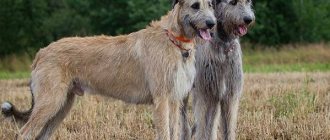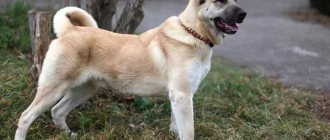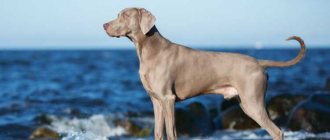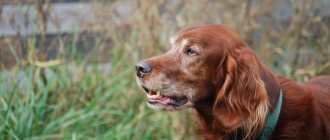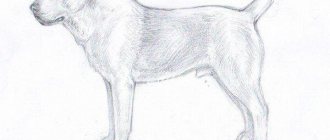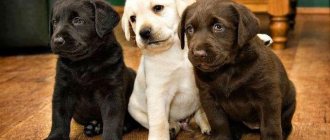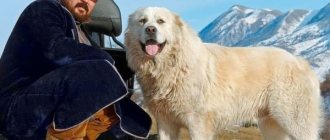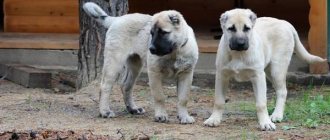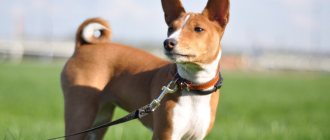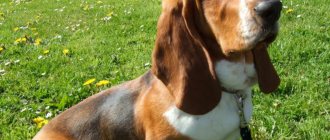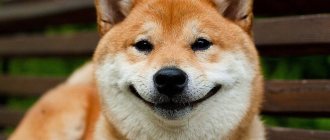History and legend
The history of this breed is beautiful and mysterious! There is a legend about the Irish Wolfhound (Irish Greyhound). It testifies to the valor of the breed, demonstrated in numerous feats. The most popular tale is about the gift of a puppy to the Prince of Wales Llewellyn by the English King John the Landless. The pet was immediately named Gellert and assigned to his baby owner.
Those troubled times were not easy for the subjects of the entire kingdom; people suffered from multiple attacks by wolves, which were found in huge numbers in the forests surrounding the settlements. The king often loved to go hunting, leaving his loved ones at home without his protection. On one of these days, he was already returning from the forest when Gellert burst into the meeting with a bloody muzzle. This horrified the monarch; he rushed to the prince’s cradle without looking back or feeling the time.
When the baby was not in the crib, the world simply collapsed around the king. Not remembering himself from anger, he grabbed a sword and pierced the faithful dog, accusing him of killing his son. Dying, the Irish wolfhound let out a piercing howl, waking up the child sleeping under the cradle. Rushing after the prince, the king saw a terrible picture: a bloody, lifeless wolf lay next to the baby. Awareness of the hopelessness of his rash act forced John the Landless to erect a monument to his faithful, brave friend, which to this day is located in Bet Gellert, named after the dog.
For many noble Europeans, having a wolfhound in their yard was considered an extraordinary luxury. The first representative of the Irish Wolfhound came to France as a gift. It was presented to Cardinal Richelieu in 1641. 11 years after this, Cromwell came to power in England and banned the export of representatives of this breed from the country. For anyone who disobeyed, the death penalty was provided as punishment.
The degeneration of the breed began several centuries later, as the number of wolves decreased significantly thanks to the Irish wolfhounds. In the 18th century the breed almost became extinct. The latter representatives were crossed with the Scottish Greyhound, Great Dane and Greyhound. The revival was taken up by A. Graham, a captain in the British Army, who in 1862 began to restore the breed. In addition to dexterity, the captain's students acquired many unique qualities. The popularity in the army ranks has again returned to representatives of the Irish Wolfhound.
Cairn Terrier
Cairn translated from English means a pile of stones. The dogs received this name for their ability to deftly drive foxes and badgers out of hiding places in rocks inaccessible to humans. Initially, Cairns were considered shorthaired Skye Terriers, until in 1910 they were recognized as an independent breed.
Cairn Terriers are medium-sized dogs up to 33 cm in height with coarse hair. The standard describes 4 colors: wheaten, cream, shades of gray and red. Each suit can have tiger stripes. Black and white coat colors are not allowed.
Kerns are unpretentious, hardy, cheerful dogs with a balanced character. They are in constant motion, ready to play, walk, and communicate for days. They willingly accompany you on trips and travels. Cairn Terriers are vigilant guards and fearless defenders. They do not feel their size; in case of danger, they bravely attack a stronger enemy.
Description of the breed
Colors
Due to the living conditions and purpose of the representatives of the breed, who spent most of their time hunting, their wool acquired specific properties. In addition to medium-length hard guard hair with zonal changes in hardness, Irish Wolfhounds have a dense undercoat. It is this pile that sets the color of the dog’s coat. The function of the undercoat is as follows:
- Protects from solar heat and wind;
- Helps maintain a constant body temperature;
- Repels water;
- Prevents ticks and other harmful insects from entering the skin.
The change in hardness depends on the location of the coat:
- On eyebrows and beard the hardness resembles wire;
- The sides and paws are covered with less hard pile;
- In the belly area the fur is more elastic and soft.
The most common colors of the Irish Wolfhound according to the standard:
- brindle;
- Sandy red, pale red, yellow to red;
- Pure white or with a slight beige tint is considered the rarest.
The standard also allows for the presence of other shades, since it does not set strict restrictions:
- Black color;
- Golden;
- Dark gray-blue;
- Different shades of gray;
- Sable with a change in tone from the root of the pile to the ends to a darker one;
- From cream to wheat.
Appearance: standard
Representatives of the Irish Wolfhound must maintain grace, endurance, and agility in appearance.
The fci breed standard is:
- The head is elongated with a proud elevation. Moderately wide forehead with a discreet dividing groove. The width of the muzzle is medium, with a deep mouth, smooth, covered with coarse hair. A slight transition to the muzzle from the forehead is slightly noticeable. Strong masticatory muscles, weak eye sockets.
- The teeth are white, straight, consistent with the typical dental pattern, and well developed.
- The nose is medium in size with round open nostrils.
- The eyes are small round with pigmented eyelid skin. Eyelids are well drawn. The color of the iris matches the palette of brown shades, which is in harmony with the color of the pet.
- Ears – Corresponding to the “rose” shape, raised by a third with the rest of the cartilage laid back. The tip is turned forward and slightly rounded. When a dog reacts to a sound, the ears rise at the base and turn forward.
- The body is not very elongated, rectangular in shape, with a curved, muscular, wide, long neck. This gives the wolfhound nobility. Not too wide and proportionally long back with weakly defined withers. The ribs of the chest are pulled back, the sternum is well developed, moderately wide, and lowered to the maximum. Powerful and wide hip part with a slight rise in the lumbar region. Tight and neat groin line.
- The limbs are very muscular, thick in proportion, and long. Strictly parallel alignment of the elbows of the forelimbs, which have well-developed muscles, a wide shoulder girdle, are placed under the body. Parallel to the body are very strong, hock joints that are located low. The hind limbs are long, with shins and knees positioned at a natural angle, and a well-developed hip apparatus. Fingers are curled up on rounded hands. Strong, curved short claws.
- The tail is well bushed, saber-shaped with a slight curve in the last third, of medium thickness and natural length. Carried high, at body level or low.
Dimensions: height, weight, length, height at withers
Irish Wolfhound puppies are born small, weighing only 400 grams. There can be up to 6 individuals in a litter. As a rule, a baby enters the family at about 6-10 weeks of life. Until this age, most representatives of the breed have already been prepared by the breeder for independent living. From this age they are trained to use a toilet, leash and collar.
Every month there is a rapid increase in puppies in height and weight up to 2 years of age. With a slight difference, slower growth is observed in females. A month and a half after birth, the puppy’s weight reaches 6 kg. The main growth, characterized by the greatest intensity, is observed in Irish wolfhounds until the 9th month of life, after which the changes are not so noticeable.
Adult pets reach a height of up to 0.9 meters, usually males grow to 0.81-0.86 m, and females to about 0.71 m. The weight of dogs should not be lower than standard values or differ significantly from them. For females, the lower threshold is 40.5 kg, and for males – 54.5 kg. In length, adult pets reach approximately 1.5 m from the nose to the base of the tail.
Minimum height at withers and weight:
- For a female: 0.71 m and 40.5 kg;
- For a male: 0.79 m (mainly 0.81-0.86 m) and 54.5 kg.
Howl and bark
The voice of representatives of the Irish Wolfhound breed “cuts through” by the end of the first year of life. If the owner keeps a dog in the apartment, then it is rare to hear the presence of a pet before this time. However, as dogs grow older, they are attached to their owners and begin to get bored alone if they are left for a long time. Then they are able to bark and even howl.
Apartment keeping is not recommended for this type of dog; they feel better in suburban areas or in the courtyards of private houses. There they can bark freely, notifying them of the arrival of guests. Most often, a dog barks in rare cases, because it mainly shows silent interest when it sees something or someone new.
Doctor Woof: how to stop a dog from barking at home?
Irish Wolfhound breed standard
The Irish Wolfhound is a big-chested giant, very similar to a Deerhound, but at the same time denser and stronger. The minimum permissible height for an adult male is 79 cm. Despite his impressive size, the “Irishman” does not look heavy and clumsy. On the contrary, in movement the dog reveals such ease and plasticity that it was absolutely impossible to suspect in it.
Irish Wolfhound
Head
The “Irish” skull is elongated, with an almost flat forehead and a narrowed, elongated muzzle.
Bite
The Irish Wolfhound can have a scissor bite or a straight bite, but the first option is preferable.
Eyes
The dog's eyes should be as dark as possible.
Ears
The Irish Wolfhound's ears are small, laid back, and pink in shape.
Neck
A purebred “Irish” is the owner of a long, well-muscled and somewhat arched neck with tightly stretched skin.
Irish Wolfhound muzzle
Frame
The dog's body is elongated, noticeably widening in the croup. The loin of the Irish Wolfhound is convex. The chest is developed, moderately deep, the stomach is tucked.
Limbs
The Irishman's legs are long and bony with sloping shoulder blades, elongated, muscular thighs and low hocks. The animal's paws are rounded, set straight, with well-arched toes and claws.
Tail
The tail is long, of good thickness, with a slight bend.
Wool
The dog's coat is quite hard, and the hair on the eyebrows and muzzle is wiry.
Color
Irish Wolfhounds have the same types of colors as Deerhounds, i.e. white, red, brindle, fawn, gray, black, etc.
I give up!
Possible defects
Not every Irish wolfhound fits 100% into the standard established by the breed standard, and deviations from the ideal can be either insignificant or threatening to disqualify the animal. Most often, the score at competitions is reduced for the presence of the following defects:
- light or too massive head;
- prominent forehead;
- short body of square format;
- curvature of the front legs;
- sagging or straight back;
- large or drooping ears;
- clubfoot or with splayed legs;
- short neck and dewlap on it;
- excessively narrowed or expanded chest;
- sharp bend of the tail;
- any color of the iris except black;
- light lobe;
- lips and eyelids of any shade except black;
- fragile hind legs;
- widely spaced fingers.
Life expectancy: how long do they live?
The Irish Wolfhound cannot boast of longevity, as it is a large breed. There are many factors associated with this that influence life restrictions to an average of 8 years.
According to some experts, representatives of wolfhounds from Ireland reach gigantic sizes of up to 86 cm at the withers, which makes them one of the tallest dogs on the planet. Large body sizes place exorbitant loads on the vital organs of the animal, which provokes rapid wear of the joints.
The largest wolfhound on the planet:
The stress resistance of pets is low, which, together with their large size, leads to a maximum lifespan of no more than 10 years .
Reproduction and lifespan
Unfortunately, the life expectancy of the Irish Wolfhound is short, a maximum of 10 years. Most representatives of the breed faithfully serve their owner for 8-9 years, even if they are completely healthy.
Puberty in dogs occurs early, up to 1-1.5 years. Males become sexually mature earlier than females, and even in puppyhood they show interest in them. Therefore, breeders separate males and females before they are 4-5 months old. A dog ready for breeding must be:
- High-breed.
- Over 1.5 years old.
- Completely healthy.
- Psychologically adequate, not aggressive.
- Friendly to people.
They match a male with a female on his territory. During the period of heat, the female becomes more aggressive, so she can push away the male. If this happens, the mating of the animals is postponed, but not for long. It is important to bring the dogs together in the middle of her heat stage, then she will most likely become pregnant. The female bears puppies for about 68-71 days.
Peculiarities
Possible diseases, health weaknesses and their prevention
In addition to the many different diseases inherent in this breed, many young representatives die at a young age from heart failure. This is a common disease in many large dog breeds. The most common diseases of the Irish:
- Cancer, improper bone healing, and heart muscle problems are caused by rapid growth;
- Entropion of the eyelid develops in some representatives and is characterized by a change in the direction of eyelash growth, namely inward towards the eyeball, irritating it when blinking;
- Hypothyroidism develops when the thyroid gland does not produce enough hormones;
- Osteogenic sarcoma is also called cancer of the appendiceal skeleton or limb bones;
- Pyoderma develops when the skin gets infected;
- Atrial fibrillation is manifested by a disturbance in heart rhythms, which can develop into von Willebrand disease with age;
- A hip malformation causes lameness in response to pain in the animal's abnormally developed hip joint;
- Cataracts are common and are growths on your pet's cornea;
- Dislocation of the kneecaps;
- Osteochondrosis of the shoulder is a congenital disease that can lead to degenerative disease of the shoulder joint;
- Von Willebrand disease does not involve blood clotting;
- Gastric volvulus occurs as a result of severe gas formation in the animal’s stomach. To prevent this condition, your pet should be fed small, frequent portions from a bowl placed at a slight incline. In rare cases, a pet with this diagnosis has to be hospitalized;
- Pneumonia is caused by the entry of pathogenic microorganisms or food particles into the dog’s respiratory tract, which is accompanied by an increase in temperature and requires immediate hospitalization.
To reduce the risk of manifestation of all of the above diseases in dogs of the breed, the following rules should be followed:
- The diet should not include harmful foods and be balanced;
- Regular physical activity with a sufficient level of intensity;
- Home environment with minimal stressful stimuli;
- Examinations by a veterinarian according to plan: for representatives under five years of age annually, for older dogs - twice a year.
- If there is any suspicion of deterioration in your pet’s health, you must immediately seek veterinary help;
- Walks should be daily and long; Irish Wolfhounds love to be in spacious areas with the possibility of free movement without restrictions, like in apartments
Characteristic diseases
Unfortunately, the Irish Wolfhound cannot be called an absolutely healthy breed. Like all the giants of the canine world, he is susceptible to many diseases, directly or indirectly related to his great growth. The reason for most of these pathologies lies not even in bad genetics, but in improper raising of the puppy. And above all, this concerns such a problem as hip dysplasia.
X-ray clearly demonstrates the condition of the joints: on the left is a picture of healthy joints, on the right is obvious dysplasia
At least until the puppy is one year old, it is important to protect it from injuries and excessive stress on the joints:
- do not allow yourself to go down stairs and steep slopes;
- avoid walking on slippery floors;
- prohibit jumping and too active games.
At the slightest sign of lameness, discomfort or pain in the joints, the dog should be shown to a doctor: a disease diagnosed at an early stage is easier to cure. However, even if external signs of pathology do not appear, after ten months of age your pet should undergo an X-ray examination to understand how things are going with the joints - perhaps the doctor will recommend maintenance or preventive medications.
Particular attention should be paid to the condition of the joints not only in puppyhood, but also in the elderly age of the dog.
In most cases, dysplasia can be treated with medication, but sometimes surgery is the only option. Other health problems that are most common in Wolfhunds include:
- bloating;
- dislocation of the kneecap;
- Hyoderma or Malassezial dermatitis;
- hypothyroidism;
- osteochondrosis of the shoulder;
- dilated cardiomyopathy;
- hygroma of the elbow;
- von Willebrand disease;
- Wobbler's syndrome;
- entropion;
- osteosarcoma;
- cataract.
Unfortunately, Wolfhounds, like most very large breeds, do not live very long - only a few of them survive their tenth anniversary.
Where to buy: the most famous nurseries
There are not many kennels that can offer purebred Irish Wolfhound. Among the establishments there are single-breed ones, in which only representatives of a given breed are produced, and multi-breed ones, where puppies are raised along with other representatives of the dog breed.
Among the special breeds, the most popular are:
- “Monsters Inc Irish Wolfhound Kennel” in Dnepropetrovsk;
- “From Sirenevy Boulevard” in Moscow;
- "Braveheart" in Moscow;
- "Solar Wind" in Moscow;
- "The Tsar's Whim" in Moscow;
- “From Kitezh City” in Simferopol.
Multi-breed nurseries that breed Irish Wolfhounds:
- "Spring City" in St. Petersburg;
- "Bel Etual" in M. O. Mytishchi;
- "Royal-Puppy" in Moscow;
- "RayaInt" in Cairo;
- “LuDog” in the city of Zheleznodorozhny, Moscow region;
- “Club MOOO Zoomir” in Moscow;
- "Cupidonas" in Vilnius;
- “From the Magic Forest” in Moscow;
- "Golden Fleece of the Urals" in Chelyabinsk.
How to choose a puppy: important tips for a future dog owner. Everyone needs to know this!
Scottish Shorthaired Collie
Smooth-coated Scottish Shepherds are the result of crossing long-haired relatives with hunting dogs. This was reflected in the appearance and character. Outwardly, they look more fit and collected than long-haired ones.
In European cynological federations, the two variants of collie are considered independent breeds and have not been bred with each other since 1993. American cynologists unite them into one breed. Colors of short-haired Scottish Shepherds, like long-haired ones:
- Sable.
- Tricolor.
- Blue merle.
Shorthaired collies are sharper, faster, more alert and noisier. They have more developed working qualities suitable for sports. Dogs will be good companions for lovers of an active lifestyle. They are happy to accompany the owner on morning jogging, skiing, and cycling.
They are kind to children. If a puppy is adopted into a family with a baby, it will grow into a caring nanny. Scottish Shepherds have not lost their herding instincts. During walks they keep the owner in sight. If the family members disperse in different directions, they try to “gather” them together, running anxiously between them.
On topic: Choose a name for your dog using a nickname generator.
Price: how much does a puppy cost?
Anyone wishing to purchase a pet from the Irish Wolfhound breed should prepare for the high cost of puppies. First of all, this is due to the high costs of breeding that breeders bear, as well as the rarity of the breed in principle. Depending on the class of puppies, the price for representatives is as follows:
- Show class - cost 60 thousand rubles. and more, since they are purchased for exhibitions with a future championship;
- Breed class - costs in the range of 36-55 thousand rubles. for a puppy and are the most popular, suitable for breeding work, participation in shows and exhibitions, but rarely become champions;
- Pet class - valued from 35 thousand rubles, differ from the established breed standard, are used exclusively as a pet without participation in mating or exhibitions.
Cheaper offers from a private breeder will not always be able to offer the buyer documents for the puppy. This must be taken into account not only for subsequent mating, but also for safety, since poor behavior, character and health can be the result of poor heredity.
How to choose a puppy
Mom with puppy
- Irish Wolfhound males are open and straightforward, which cannot be said about females. So when getting acquainted with the breed for the first time, stop at the “boy”, it’s easier to work with him.
- To study the character of your pet, choose a fully grown puppy, not a two-month-old puppy. Too young “Irish” people have little individuality, so they are all equally cute and funny.
- Don’t avoid getting to know the baby’s mother and father in order to see the pet’s development prospects.
- Appreciate the atmosphere in the nursery. Dirty, cramped cages, apathetic puppies with signs of rickets, the refusal of the breeder to demonstrate at least one of the sires indicate that here they are simply making money on dogs.
- Inquire about the age of the bitch whose puppies are being offered to you, and refuse to purchase if a litter from a 7-year-old “grandmother” is for sale.
- Look at the veterinary passport of the Irish Wolfhound puppy, which should contain notes on age-appropriate vaccinations.
- A responsible breeder always tests the litter for at least some of the genetic diseases, so if the nursery offers customers a look at the results of animal examinations, this is a plus for the institution’s karma.
- Buy 6, or better yet, 12-week-old puppies and discard 5-week-old babies taken from the bitch too early.
- The cost of an Irish Wolfhound puppy has nothing to do with its color. If a seller tries to inflate the price tag for a unique shade of wool, he is simply being cunning.
- When purchasing an older puppy, ask the breeder if the wolfhound is familiar with a leash and what commands it knows. With experienced specialists, “teenagers” are socialized, obedient and respond to certain commands.
Owner reviews
Natalia, 28 (Moscow)
They took him when he was little, a month and a half old, and he paid a decent price; he spent almost a month’s salary on him. But they didn’t regret it one bit. My husband and I just got a “big baby.” It was very funny to watch the first two years, when our Edmund began to turn into a big clumsy dog from a baby. He constantly ran under the table, touched everything, and was sincerely surprised that he could not crawl under the low table, which he could have done a week and a half ago. It’s just problematic to walk all the time, we are busy, and our “child” needs to be walked constantly.
Roman, 34 (Chelyabinsk)
The dog was not mine, but a neighbor’s, who often went on business trips. I had to babysit him sometimes for 2-3 weeks, but I don’t regret having that experience. It’s difficult to take care of the fur after walking, but it’s tolerable, because the dog is very kind and affectionate and loves children. I even started to miss him when the neighbor suddenly returned, sold the apartment and left in an unknown direction. Now they are thinking about purchasing their own Count.
Alexey, 57 (Tyumen)
We gave him a puppy for our anniversary, he was already an adult, he was 3-4 months old. I suffered a lot while I got used to his schedule, it was very difficult to take care of his fur, and I also constantly trimmed his eyebrows and beard so that Berkhard would not suffer. But the dog is very friendly. My granddaughters cannot get enough of how they come to visit, constantly play with him, hug him, and lie down next to him. Never bitten and dropped before. But as soon as I whistle or call out, it breaks down instantly. A greyhound is a greyhound...
Scottish Terrier
The breed was bred to protect the farm from rodents, hunt and scare away burrowing animals. Officially recognized in 1879. Scotch Terriers are stocky, short-legged dogs with a beard, mustache, and eyebrows. Average height 28 cm.
Among Scottish terriers there are dogs of three colors:
- uniformly black or interspersed with white, silvery hair.
- wheat;
- brindle, light hair allowed. All colors allow white spots on the chin and chest.
Scotch Terriers recognize only one owner, but are happy to communicate with all households. They avoid strangers and do not like familiarity. Children are treated differently. Children's liberties are suppressed with light nipping, and they play with pleasure with older children.
Scotties are highly trainable, but their training is sometimes hindered by their innate stubbornness. Scottish Terriers are independent dogs with opinions of their own. If it does not coincide with the owner’s requirements, the dog refuses to follow commands, go for a walk or play.
Characteristics: pros and cons
Let's look at the characteristics of the breed in detail:
Character
- Affectionate, friendly, friendly huge dogs. They are difficult to anger or lose their temper. They rush at a person only as a last resort, when they feel a real threat to their life in relation to their owner.
- Very trusting and good with children and other pets.
- If you annoy them for a long time, the “Irish” simply leave, very rarely snapping or growling .
- They do not howl or bark for trifles or for no particular reason. Due to the rapid physical development of the pet’s body, it takes a long time for the pet to mature; puppy behavior persists for up to a year and a half.
- The intelligence of the breed is very high , which often does not allow it to be considered an ordinary pet. When entering a house, such dogs must immediately feel the owner of the home, become attached to him, find a common language and contact in general. Therefore, you can’t beat the “Irish” if the training doesn’t go well. Experienced professionals will help you do this without aggression, since the dog is very sensitive to raising its voice, hitting and other violations of its dignity.
- Loneliness is often a concern, so the breed is not suitable for busy people . Walking every day requires up to an hour of time, followed by wiping off dirt and tidying up the fur. Very high need for communication with the owner .
Hollywood smile!
Behavior
- Very sensitive to rude and cruel treatment, but not vindictive.
- They are affectionate with children, friendly, and attached to their owner. Sometimes this connection is so strong that pets, at the same time as the owner’s illness, experience illness with similar symptoms.
- Dogs easily adapt to the activity level of their owner ; if he prefers to stay at home and lie down all the time, the Irish Wolfhound will turn into a lazy one. With a lot of activity on the street, the dog can easily perform even large athletic loads. A dog acquires habits early, which they retain throughout their lives.
- Due to the fact that the breed is a hunting dog, residents of country houses should carefully monitor restrictions on access to birds or other types of animals . A dog can easily chew on its “prey” for the sake of ordinary interest. Even if the dog has been accustomed to other animals from an early age, it cannot be ruled out that it will attack “strangers.”
- It has excellent watchdog qualities . When using a dog for these purposes, it is necessary to take into account the cruelty of the pet, since it will fiercely rush to the defense of its owner. To prevent such manifestations of character, aggression should be weaned from an early age.
Shedding
Combing should be done more thoroughly during seasonal molting. Then the pet will have a renewed coat, which should be combed well. In other periods, trimming the eyebrows and beard is sufficient.
Proper care of a dog's fur: what to comb and how to comb out tangles?
Personality of the Irish Wolfhound
One look at the Irish Wolfhound makes you think that this is a typical tough nut to crack and will not be easy to get along with. In reality, everything is exactly the opposite: any average “Irish” is insanely attached to the owner. The dog does not servile or humiliate himself, but this does not prevent the animal from cherishing communication with the person who took him into his home. In addition, dogs of the Irish Wolfhound breed masterfully control their own aggression, reserving this quality for a serious opponent and never using it against someone who is obviously weaker. So feel free to leave your children in the care of your pet: he will approach the matter with all responsibility and caution.
Irish Wolfhound plays with a cat
Since the ancestors of the “Irish” always hunted wolves and never people, turning these good-natured giants into suspicious bodyguards will be problematic. Even towards strangers, Irish wolfhounds are quite peaceful if they do not emit too obvious a threat. But the shaggy “thugs” have difficulty establishing contacts with other animals. And if the wolfhound still agrees to tolerate the presence of a dog of average build, then he will certainly start a conflict with some Papillon. And the point here is not so much about rivalry as about natural instincts. The Irish Wolfhound does not know the difference between a slop rat, a stray cat and a miniature dog. For him, they are all prey with which he can have good fun, and most importantly, without risk to health.
It is believed that leadership habits are alien to Irish wolfhounds, therefore, in principle, dogs should not encroach on their master’s authority. Nevertheless, the breed is distinguished by its independence and independence in decision-making, so it is better to behave seriously with its representatives, without flirting or coddling. Animals are not prone to jealousy and hiding from an Irish wolfhound in order to cuddle a cat or scratch another dog behind the ear is clearly not worth it. At the same time, shaggy giants can be very offended, reacting especially painfully to what they themselves think is an unfair punishment.
With age, the character of the Irish Wolfhound begins to change, which is generally typical for large breeds. Typically, “old people” are more capricious, touchy and irritable, and you will have to put up with this. The activity of an elderly animal also decreases, so the “Irish” who have passed the 7-year mark more often lie down in their corner, remaining undaunted wolf hunters, perhaps only somewhere deep in their souls.
Wolfhound with his beloved owner
New friend
Conditions of detention
Where is it better to live: in an apartment or a house?
Representatives of the breed feel better in large houses, as they can often be in the fresh air and move actively. For apartment housing, it is necessary to provide conditions for keeping the pet in the form of a designated area for bathing and combing during the molting period, as well as sleeping. The resting place should be soft, as the dog will feel discomfort on a hard surface.
Beautiful do-it-yourself dog houses for an apartment: 6 detailed master classes
Considering that the Irish Wolfhound is a large animal, it is best to allocate a separate sofa. The pet will get accustomed to this place and get used to it from the first days.
In country houses, kennel keeping for pets is not suitable, since they need to see their owner often and feel his affection and attention.
How should you walk?
The dog does not need active and long walks; it is enough to provide a spacious place for walking, which is a necessity for the “Irish”. This is especially true for walks without a leash, when the dog can run around on his own at a speed that is convenient for him. For apartment living, it is better to create a special daily routine, according to which time will be allocated for a daily walk:
- From about 6.00 to 7.00, dogs wake up on their own, require a short walk of 10-15 minutes, after which they can have breakfast with an appetite;
- The morning “throw march” occurs from 10.00 to 11.30 am. In this case, the dog should be allowed to run at least 3-5 kilometers with the owner; during this time and distance, if the dog is kept freely, it can run up to 20 km. After such a walk, the pet should be well fed with a full breakfast and provided with a 2-hour rest;
- A short afternoon walk takes place at 15.00 and lasts approximately 10-15 minutes, followed by lunch and rest;
- The evening “throw march” is best carried out from 18.00 to 19.00, providing the same load as in the morning. After returning home, the pet should have a good dinner and rest for at least 2 hours;
- Before going to bed, from 22.00 to 23.00, a short walk is taken with light feeding upon return.
If such a busy schedule is followed as closely as possible, the pet’s health will rarely bother him, and he will only have to contact the veterinarian for routine vaccinations.
Sheltie
The breed was bred on the Shetland Islands, located northeast of Scotland, hence the second name - Shetland Sheepdogs. The Sheltie's ancestors were dogs that looked like small Spitz dogs. During selection, they were crossed with Scottish longhaired shepherds, Papillons, and spaniels. As a result, the Sheltie inherited the appearance of the Collie, and other breeds influenced the formation of their character.
Longhaired Collie and Sheltie.
At the dawn of the appearance of Shelties, they guarded yards, signaling danger with loud barks, and helped herd short-legged Shetland sheep. Now they have become house companions.
Shelties look like smaller versions of long-haired Scottish Sheepdogs. The height of the dogs does not exceed 39.5 cm, maximum weight is 10 kg. They inherited the colors of their large collie relatives, but added two more to the standard:
- bi-color - a combination of black and white;
- bi-merle - marbled without tan.
Shetland Sheepdogs are often called mini collies, but the temperament and personality of these dogs vary greatly. Shelties are active, nimble dogs that find it difficult to sit still. They follow their owner everywhere and participate in household chores. They treat animals kindly, do not try to dominate, love to “talk” and express emotions with sounds.
It is a mistake to treat the Sheltie as a decorative “sofa” dog. With a lack of movement and mental stress, Shetland Sheepdogs' character deteriorates. They grow up naughty, make a mess in the apartment, and run away on walks. Shelties are among the top ten smartest dogs.
See on topic: The smartest breeds of small dogs.
Necessary care
What to feed: nuances and nutritional features
The stomach and digestive system of the animal are very sensitive to low-quality, hot, cold or fatty food, which results in gastric volvulus and other troubles. Sometimes it can even threaten the pet’s death and other complications. The following feeding rules must be observed:
- After each meal, the dog should receive the necessary rest. If this is a full dinner, lunch or breakfast, then the duration of the rest should not be less than 2 hours. For small snacks, a half-hour or hour-long nap is enough;
- You should not offer large portions, since a lot of food is accompanied by the capture of a large amount of air. This will be an additional factor for more intense gas formation in the pet’s gastrointestinal tract. It is better to divide the daily portions into a larger number of doses;
- The bowl of food should be placed slightly at an angle, which will reduce the amount of air the dog swallows when eating;
- Vitamins or other substances must be introduced into food strictly on the recommendation of a veterinarian. You should also clarify the amount and type of yeast that is necessary for proper absorption and digestion of the dog.
The following types of feeding are suitable for the Irish Wolfhound:
- Ready-made dry food;
- Natural products.
When choosing dry food, you must first accustom your pet to it correctly; you cannot suddenly switch it to a completely different food. In addition, only feed is suitable. This will significantly reduce the cost of preparing fortified food balanced in other nutrients.
No less cheap is eating from natural products . The Irish Wolfhound cannot eat all types of meat, fish and other foodstuffs. In addition, the owner will have to prepare it himself, taking into account the calculation of the amount of minerals and vitamins in a serving.
IMPORTANT: Mixing natural products with dry pet food is unacceptable!
For the younger generation of “Irish”, the feeding process should be approached especially responsibly, since any discrepancies in the daily norm of nutrients and vitamins provoke insufficient muscle development, weak growth, poor bone structure, and rickets.
Puppies should be given food depending on their age in the following quantities per day:
- Up to 7-8 weeks – 6 times;
- From 9 weeks to 3 months – 4 times;
- From 3 months to six months – 3 times;
- Over six months – 2 times;
- From a year and into adulthood, the pet is fed 2 times.
Irish Wolfhounds are fed only food at room temperature after a walk. Your pet should have unlimited and constant access to water!
Cerberus diet depending on age: what should you feed your puppy?
20 minutes are allocated for feeding; if the dog cannot cope with the allotted portion, the leftovers should be hidden from it.
List of useful foods for the Irish Wolfhound:
- Rice and buckwheat porridge ;
- Fruits;
- Vegetables;
- Greenery;
- Marine boneless fish;
- The cottage cheese is only tender;
- Lean meat of chicken, beef, rabbit after heat treatment (boil or scald).
List of prohibited pet products:
- Chocolate;
- Bread;
- Any legumes;
- Bones with a tubular structure;
- River fish;
- Seasonings;
- Excessive salt;
- Sweets;
- Smoked meats;
- Fatty meats.
How many times should I wash and how should I comb it?
Combing
The Irish Wolfhound has a wiry, hard guard coat with a dense undercoat, which requires careful brushing during the molting period. The smell of “dog” from the animal is practically not felt. The hair does not get tangled and can be combed quite easily. Procedures must be carried out after each walk so that the coat does not become tangled and maintains its structure, but only as needed.
Full combing is done no more than 2-3 times a week using natural bristle brushes or metal combs . In addition to keeping your pet tidy and clean, brushing helps your pet enjoy a massage, removes dead hair, and improves blood circulation.
The procedure is as follows:
- It starts with the hair on the head, using a metal comb;
- Smoothly move to the body with careful combing of the sides towards the base of the tail;
- The limbs and tail are processed last;
- In the same order, the wool is combed with a brush with natural bristles against the wool, and then in the direction of its growth.
A haircut
Shearing wool for the “Irish” is contraindicated, especially when it comes to exhibition specimens. Trimming is used for them in autumn and spring, once per season.
Trimming is done using a stripper, trimming knife or fingers. Externally, a trimming knife looks like a comb with non-sharp teeth of different frequencies and lengths. He should not cut the wool, but only replace the action of pulling out the wool instead of the index finger.
Only those individuals whose exhibition career has ended are clipped.
Bathing
Accumulated dust and dirt are removed with a damp cloth. Bathing is recommended no more than 1-2 times a year using a special shampoo for breeds with hard hair. For exhibition representatives, this procedure is mandatory before the show. It is not allowed to use conditioner to soften the hair structure, since the Irish wool should not be soft, as it will lose its protective properties.
It is better to replace bathing with dry cleaning. To do this, dry shampoo is rubbed into the coat all over the body, and then thoroughly combed out with a comb. Use a damp towel to wipe your pet's face after each feeding so that no food residue remains on the beard.
Nutrition
The Irish Wolfhound is considered a specific breed. It has a heavy and powerful skeleton, grows quickly, and has well-developed ligaments. Food must be selected in accordance with these characteristics.
Perhaps there will be fewer problems with this particular breed if the owner buys ready-made food for the animal. Otherwise, when cooking naturally, the portions will be such that an XXXL size bowl will be required.
But even if this did not stop the ardor of the caring owner, it is worth knowing that the dog has a capricious gastrointestinal system. This means you should limit your consumption of legumes and fermented milk products.
If the choice falls on industrially produced dry food, then it is important that it is of high quality. As a rule, such products already contain the necessary additives in the form of vitamins and minerals.
This means there is no point in purchasing anything additional. Irish Wolfhound puppies should receive dry food in a soaked form until the baby teeth are replaced by molars.
The frequency of feedings is usually indicated on the package and rarely exceeds 5-6 times a day. Adult dogs receive larger doses, but less frequently, up to twice a day. It is important to maintain a balance in nutrition throughout the dog’s life, not only in puppyhood and prime, but also in old age.
Otherwise, the dog will greatly sag in external characteristics, and physically weaken quickly. It is also important to remind about the drinking regime - a bowl of clean water should never be empty, and the water should be renewed once a day.
Training and education
Due to their high intelligence, dogs of this breed are able to learn commands, perform the specified actions and obey literally within a few repetitions, or even on the fly. However, before you start training, you need to know the important rules for raising these dogs. They are as follows:
- When giving a command, the owner should not raise his voice. Any high-pitched sounds for a dog are an indicator of fear and uncertainty, so a confident, even, calm tone will help to quickly establish contact with the “Irish”;
- The prohibitions for a puppy should be the same as for an adult, which must be observed by all family members;
- You should not allow a stranger to pet the dog, despite the fact that the puppy is affectionate and curious;
- Training and education are carried out without the use of rudeness or harsh measures associated with physical violence;
- In order for socialization to go faster, you need to take the dog for a walk with a lot of stimuli, this will help the pet feel more calm and confident in the city.
Key points in training
- Dogs begin to be trained at 2-3 months, when the puppy already knows its name.
- Until this time, you need to accustom your pet to a diet and walking schedule, show him that the person in the house is in charge. Irish Wolfhounds can be stubborn, so their temper must be broken first.
- Harsh methods are absolutely not suitable. You cannot raise your voice at a wolfhound, much less hit him. The pet may become withdrawn, irritable and angry.
- Collective training goes well, where dogs try to imitate each other. For large breeds, it is important to know the primary rules of behavior in human society and the basic commands: “near”, “place”, “no”.
Read about how to properly train a dog in the article: “Training a puppy: effective methods from dog handlers, learning commands at home.”
What to call: nicknames for boys and girls
The following names are best suited for a boy:
- Chase;
- Maurice;
- Harold;
- Rudolf;
- Vegas;
- Snake;
- Tyson;
- Olympus;
- Baron;
- Oscar;
- Spartacus;
- Sonic;
- Raymond;
- Lyon;
- Duncan.
The most sonorous nicknames for girls are:
- Elbe;
- Terra;
- Cherry;
- Lucky;
- Fiona;
- Rhonda;
- Lilu;
- Tiara;
- Elsa;
- Cleo;
- Richie;
- Kara;
- Sandy;
- Gerda;
- Gretta.
West Highland White Terrier
The breed was bred in the rocky terrain of western Scotland. Presumably the ancestors were Cairn Terriers. West Highlands skillfully hunted small animals, pulling them out of crevices and holes. Now they have turned into companion dogs. Breeders and owners have shortened the long name of the breed and call them Westies or Westies.
Outwardly, the West Highland White Terrier resembles a plush toy with semi-long snow-white fur, dark beady eyes and neat triangular ears. However, first impressions are deceiving. Westies are stronger, stronger, and more energetic than decorative dogs.
These are inquisitive, noisy fidgets. They don't like loneliness. If there is a lack of attention, they may even refuse to eat. They treat children kindly, but do not tolerate free treatment. They do not get along well with pets, not wanting to share the owner's attention.
Deerhound and wolfhound: what are the differences?
The conformity of the typical Irish Wolfhound is described in the Breed Standards .
- Compared to a regular Deerhound, the Irishman's appearance should be more majestic, massive, heavy and tall;
- The wolfhound is inferior in speed to the deerhound, but not in energy;
- The Irish dog has an elongated format and body;
- The ratio of the wolfhound to the deerhound is the same as the latter to the typical greyhound;
- Despite the similar body structure, the “Irish” have gigantic strength to deal with caught prey, and good speed to first catch it;
- If we compare the speed and type of temperament of a deerhound with an Irish wolfhound, then the first will correspond to a racehorse, and the second to a riding horse;
- In relation to the size of the body, the Irishman's head should be stronger than that of the Deerhound. The latter does not have a smooth transition from the forehead to the muzzle, like a wolfhound, but the forehead is quite flat.
Wolfhound from Ireland
Deerhound
Possible diseases and methods of treating them
Pet diseases are divided into 2 types: genetic and acquired. Irish Wolfhounds have a rather weak musculoskeletal system, which makes their gait a little unsteady. A dog can easily lose its balance and fall, especially on slippery surfaces. A veterinarian should treat an injured animal.
Representatives of this breed have one more specific genetic disease - von Willebrand disease. It consists of involuntary nosebleeds. Also, ichor can periodically be discharged from the dog’s throat. If this happens infrequently, there is no need to panic. But regular hemorrhage in a dog should alert you. Be sure to show it to a specialist in this case.
Among the acquired diseases in wolfhounds are colds, helminthic infestations and cataracts. Preventive care will help minimize the risk of their occurrence. A couple of final tips: regularly give your dog tablets or capsules against parasites, and do not forget to vaccinate him against infections. Also inspect her body for ticks, especially in summer.
Interesting Facts
- Irish wolfhounds are traditionally recruited to serve in the Clover Leaf Guard Lava. Dogs are required to participate in charity events, major official events, and parades.
- The English, Irish, Romans and Celts, who lived in the territories of origin of the breed, cannot be called breeders, although they have a certain pattern of breeding these dogs. The beauty of a pet was assessed solely by its working qualities. There is evidence that once upon a time the “Irish” could have long, soft hair of any color, but they valued speed, strength and size.
- The dog has a herd instinct, which is reflected in history as the use of a large group of animals for hunting. According to documents, in 1561, more than 200 Irish Wolfhounds, working in a pack, drove deer during the hunt.
- The best representative of the breed is awarded the Graham Prize at the annual traditional show.
- There are many references to the last purebred of the breed named Barn.
List of suitable nicknames
When choosing, you should focus on a simple, easy to pronounce name. The main thing is that you like it, then the pet will love its nickname.
What to name a boy: Karl, Vist, Luther, Vector, Jack, Tower, Tybalt, Knife, Dolon, Werther, Martin, Bernard, Gerimi, Dare, Georg, Booms.
Nicknames for girls: Sparta, Margot, Scarlett, Geraldine, Krista, Ladea, Hera, Mandarin, Vesta, Raffi, Baby, Lilith, Mackey, Troy, Alphys, Kailani.
Photos and pictures
To give you a better idea of the “scale” of wolfhounds, here is a photo of an adult dog on its hind legs with a person:
And here is an adorable photo of the puppy:
Guess which is the deerhound and which is the wolfhound?
Delightful mestizos of this dog breed in the photo:
Purebred puppies
Labrador + Irish Wolfhound = tons of cuteness
German Shepherd and Irish mix
The fruit of forbidden love between a bobtail and a wolfhound
And for dessert: wonderful drawings!
Lamb at home - lion on the hunt
Bearded Collie
The breed got its name because of the long, straight hair that covers the body and head. On the muzzle it resembles a beard and mustache. According to one version, lowland Polish shepherd dogs brought to Scotland in the 16th century took part in the breeding. According to other sources, “bearded dogs” appeared as a result of crossing bobtails and long-haired Scottish shepherds.
Bearded collies have an interesting coat property. Puppies are born completely dark. With age, the hair lightens, and by the age of 3 a permanent color is formed. The color of the bearded coat is varied: shades of black, gray, fawn, brown.
Bearded collies are active, affectionate, friendly, sociable dogs with a stable psyche. They become very attached to their family, are always happy to join children in games, and treat children with care. They do not tolerate loneliness and separation well. Loud sounds of thunder, fireworks, or a vacuum cleaner unsettle dogs.
Bearded men make unimportant guards. Dogs greet strangers with excited barking, without showing suspicion. Pets are treated kindly. On the street they can chase other people's cats and birds for sport.
Character and temperament
The Deerhound is a gentle and loyal, calm and dignified dog. He is noble and will not show aggression towards humans, although he is distrustful of strangers.
It is interesting that the reindeer hound manages to combine “duality” in itself: at home there is peace itself, but in the forest or on the street a hunting passion immediately awakens in it.
Pros:
- smart;
- loyal;
- calm;
- passionate hunter;
- not aggressive;
- patient;
- does not bark for any reason;
- loves children.
Minuses:
- does not protect;
- doesn't like to be alone;
- active;
- has a strong hunting instinct.
Dandie Dinmont Terrier
The breed was developed in Scotland by crossing Skye and Bedlington Terriers. Farmers adapted dogs to catch rodents and hunt badgers and foxes. Sensitive dogs notified the owner of the arrival of a stranger and possible danger. The breed was named after the literary hero Dandy Diamond from the novel by Victor Hugo, who kept a whole pack of terriers.
Dandie Dinmont Terriers are small dogs with a long body, short limbs and a fluffy cap on their heads. The standard allows 2 colors:
- Pepper - from pale gray to blue-black with a silver cap.
- Mustard - from light sand to red-brown with a cream-colored cap.
Behind the toy appearance of the Dandie Dinmont Terrier lies an independent, decisive character. On the street, he can provoke a fight with a large dog if he senses danger. The Dandie Dinmont chooses one owner and treats other family members evenly and kindly. Loves to play with children. He behaves warily, even hostilely, with strangers.
Scottish Setter Gordon
The Gordon Setter is a gundog breed created to help hunters. The dogs' task is to find shot game and freeze in a stance next to the prey. The breed was purposefully bred on the basis of English black and tan hunting dogs, crossed with Spanish hounds, bloodhounds, and pointers.
The breed received the name “Gordon” in honor of Dukes Alexander and George Gordon. They lived in a castle in the north of Scotland near Loch Ness. In 1820, Alexander organized the first black and tan setter kennel in an attempt to improve the breed. 7 years later, Georg continued his work.
Gordons are the largest and heaviest of the setter group. They have shiny, soft fur and drooping long ears. Only one color is allowed - blue-black with red markings on the limbs, muzzle, neck, chest and under the tail.
Scottish Setter puppies need early socialization and training. It is almost impossible to wean an adult dog from bad habits due to its innate stubbornness. But a trained Gordon Setter is created to work together with a person. This is an intelligent, hardworking, discreet dog, ready to follow its owner everywhere.
Scottish Setters are still kept by hunters. Gordons are famous for their sensitive sense of smell and ability to work tirelessly in the fields and forests, in swamps and reservoirs.
Scottish Deerhound
The ancestors of Deerhounds accompanied the ancient tribes that inhabited the territory of Scotland. This is evidenced by rock paintings and clay figurines found at excavations. But the heyday of the breed occurred in the 16th – 19th centuries. At that time, hounds were bred in the noble strata of society to hunt large animals. The Deerhound is capable of single-handedly driving and killing a deer weighing more than 300 kg.
The Scottish Greyhound ranks 9th on the list of the 30 largest breeds. This is a tall, wiry dog with a long body and limbs, short, hard, wire-like hair.
The character of deerhounds is dual. When hunting, they turn into a ball of energy and are famous for their lightning-fast reactions and tenacity in pursuing game. They behave peacefully at home. They are sensitive to their owner's mood and love to take a nap. They are patient with younger family members.
Scottish dog breeds are still used for their intended purpose - for herding livestock or hunting. But more often they are prepared for exhibitions or kept simply as domestic companions.
Dear readers, your additions will make the review much more informative and interesting. Write comments!
